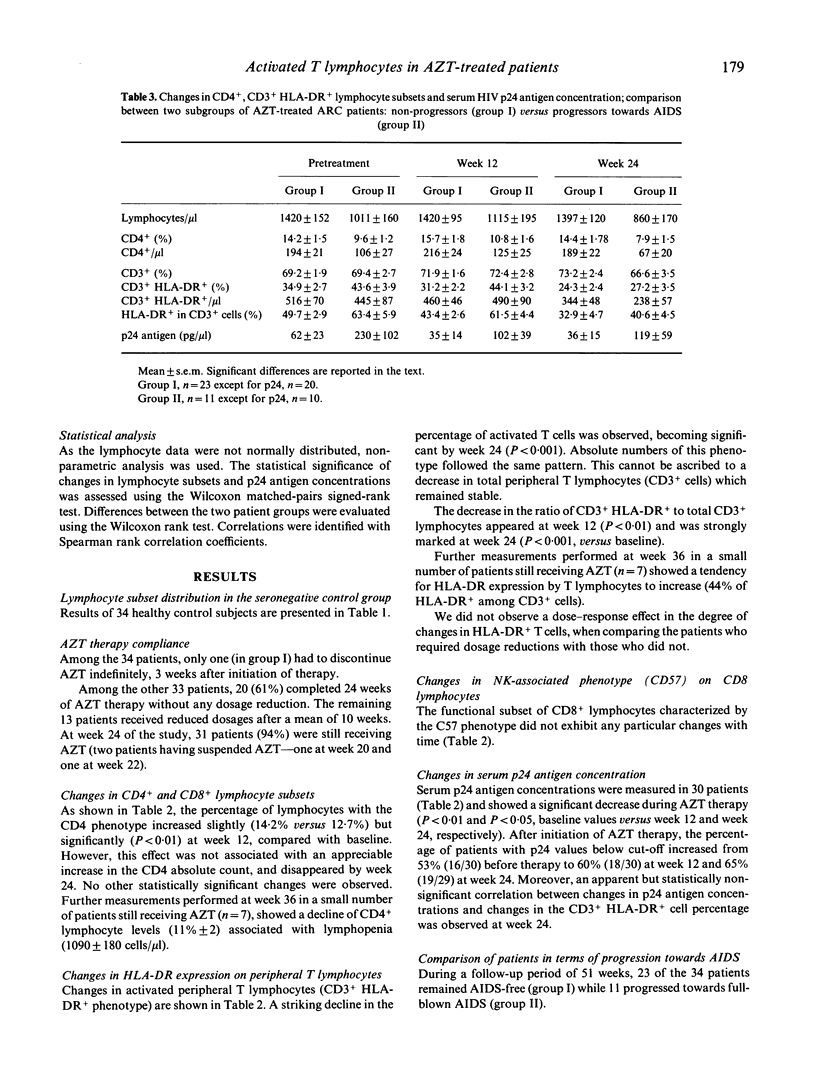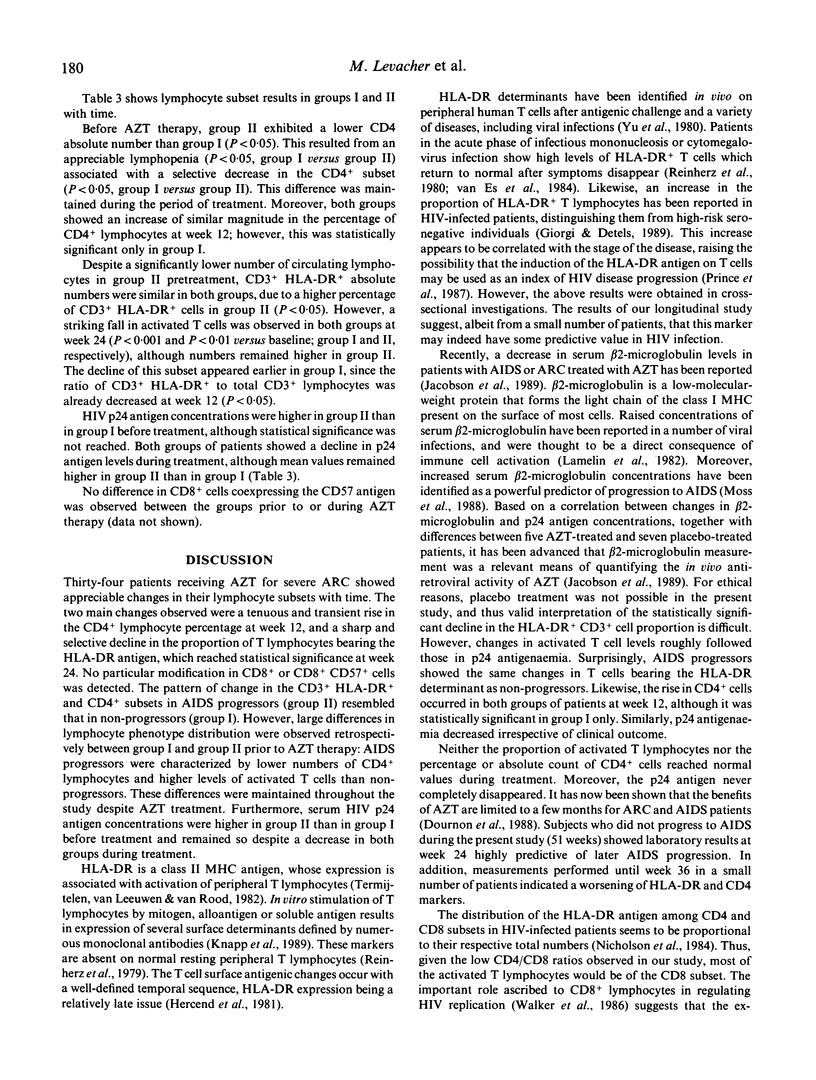Abstract
Reductions in the percentage and absolute number of CD4+ lymphocytes, as well as abnormally high levels of activated peripheral T lymphocytes (CD3+ HLA-DR+ phenotype) and an increased proportion of CD8+ cells coexpressing the CD57 surface antigen (involved in natural killer activity) have been reported in HIV infection and associated with disease progression. We prospectively measured these subsets of lymphocytes in 34 patients with advanced AIDS-related complex (ARC) treated with azidothymidine (AZT). Peripheral blood lymphocyte phenotyping was performed before treatment, then at weeks 12 and 24. A striking fall in the proportion of activated T lymphocytes from baseline was observed (P less than 0.001) at week 24. In contrast, the percentage of CD4+ cells showed a slight and transient rise at week 12 (P less than 0.05). No modification in levels of CD8+ or CD8+ CD57+ cells was detected during the study. Of the 34 patients, 11 developed AIDS, and 23 remained AIDS-free during 51 weeks of follow-up. Similar patterns of change in CD4+ and HLA-DR+ CD3+ lymphocytes were found in the AIDS progressors and nonprogressors. Likewise, HIV p24 antigenaemia showed parallel decreases in both groups of patients. Although changes in CD4+ cells, p24 antigenaemia and HLA-DR-reactive T lymphocytes were not predictive of clinical outcome, large differences existed between the two groups prior to the initiation of therapy. The short-term onset of AIDS was associated with lower CD4+ cell numbers, higher levels of serum p24 antigen and a greater proportion of activated T lymphocytes. Our results suggest that the possible interest of T lymphocyte activation markers, in conjunction with conventional phenotyping, should be investigated further.
Full text
PDF





Selected References
These references are in PubMed. This may not be the complete list of references from this article.
- Dournon E., Matheron S., Rozenbaum W., Gharakhanian S., Michon C., Girard P. M., Perronne C., Salmon D., De Truchis P., Leport C. Effects of zidovudine in 365 consecutive patients with AIDS or AIDS-related complex. Lancet. 1988 Dec 3;2(8623):1297–1302. doi: 10.1016/s0140-6736(88)92903-0. [DOI] [PubMed] [Google Scholar]
- Fischl M. A., Richman D. D., Grieco M. H., Gottlieb M. S., Volberding P. A., Laskin O. L., Leedom J. M., Groopman J. E., Mildvan D., Schooley R. T. The efficacy of azidothymidine (AZT) in the treatment of patients with AIDS and AIDS-related complex. A double-blind, placebo-controlled trial. N Engl J Med. 1987 Jul 23;317(4):185–191. doi: 10.1056/NEJM198707233170401. [DOI] [PubMed] [Google Scholar]
- Giorgi J. V., Detels R. T-cell subset alterations in HIV-infected homosexual men: NIAID Multicenter AIDS cohort study. Clin Immunol Immunopathol. 1989 Jul;52(1):10–18. doi: 10.1016/0090-1229(89)90188-8. [DOI] [PubMed] [Google Scholar]
- Goudsmit J., de Wolf F., Paul D. A., Epstein L. G., Lange J. M., Krone W. J., Speelman H., Wolters E. C., Van der Noordaa J., Oleske J. M. Expression of human immunodeficiency virus antigen (HIV-Ag) in serum and cerebrospinal fluid during acute and chronic infection. Lancet. 1986 Jul 26;2(8500):177–180. doi: 10.1016/s0140-6736(86)92485-2. [DOI] [PubMed] [Google Scholar]
- Gratama J. W., Kluin-Nelemans H. C., Langelaar R. A., den Ottolander G. J., Stijnen T., D'Amaro J., Torensma R., Tanke H. J. Flow cytometric and morphologic studies of HNK1+ (Leu 7+) lymphocytes in relation to cytomegalovirus carrier status. Clin Exp Immunol. 1988 Nov;74(2):190–195. [PMC free article] [PubMed] [Google Scholar]
- Gupta S. Abnormality of Leu 2+7+ cells in acquired immune deficiency syndrome (AIDS), AIDS-related complex, and asymptomatic homosexuals. J Clin Immunol. 1986 Nov;6(6):502–509. doi: 10.1007/BF00915256. [DOI] [PubMed] [Google Scholar]
- Hahn T., Schattner A., Handzel Z. T., Levin S., Bentwich Z. Possible role of natural cytotoxic activity in the pathogenesis of AIDS. Clin Immunol Immunopathol. 1989 Jan;50(1 Pt 1):53–61. doi: 10.1016/0090-1229(89)90221-3. [DOI] [PubMed] [Google Scholar]
- Hercend T., Ritz J., Schlossman S. F., Reinherz E. L. Comparative expression of T9, T10, and Ia antigens on activated human T cell subsets. Hum Immunol. 1981 Nov;3(3):247–259. doi: 10.1016/0198-8859(81)90021-5. [DOI] [PubMed] [Google Scholar]
- Jacobson M. A., Abrams D. I., Volberding P. A., Bacchetti P., Wilber J., Chaisson R. E., Crowe S., Howard W., Moss A. Serum beta 2-microglobulin decreases in patients with AIDS or ARC treated with azidothymidine. J Infect Dis. 1989 Jun;159(6):1029–1036. doi: 10.1093/infdis/159.6.1029. [DOI] [PubMed] [Google Scholar]
- Knapp W., Rieber P., Dörken B., Schmidt R. E., Stein H., vd Borne A. E. Towards a better definition of human leucocyte surface molecules. Immunol Today. 1989 Aug;10(8):253–258. doi: 10.1016/0167-5699(89)90135-7. [DOI] [PubMed] [Google Scholar]
- Lamelin J. P., Vincent C., Fontaine-Legrand C., Revillard J. P. Elevation of serum beta 2-microglobulin levels during infectious mononucleosis. Clin Immunol Immunopathol. 1982 Jul;24(1):55–62. doi: 10.1016/0090-1229(82)90088-5. [DOI] [PubMed] [Google Scholar]
- Lane H. C., Fauci A. S. Immunologic abnormalities in the acquired immunodeficiency syndrome. Annu Rev Immunol. 1985;3:477–500. doi: 10.1146/annurev.iy.03.040185.002401. [DOI] [PubMed] [Google Scholar]
- Lanier L. L., Phillips J. H., Hackett J., Jr, Tutt M., Kumar V. Natural killer cells: definition of a cell type rather than a function. J Immunol. 1986 Nov 1;137(9):2735–2739. [PubMed] [Google Scholar]
- Maher P., O'Toole C. M., Wreghitt T. G., Spiegelhalter D. J., English T. A. Cytomegalovirus infection in cardiac transplant recipients associated with chronic T cell subset ratio inversion with expansion of a Leu-7+ TS-C+ subset. Clin Exp Immunol. 1985 Dec;62(3):515–524. [PMC free article] [PubMed] [Google Scholar]
- Moss A. R., Bacchetti P., Osmond D., Krampf W., Chaisson R. E., Stites D., Wilber J., Allain J. P., Carlson J. Seropositivity for HIV and the development of AIDS or AIDS related condition: three year follow up of the San Francisco General Hospital cohort. Br Med J (Clin Res Ed) 1988 Mar 12;296(6624):745–750. doi: 10.1136/bmj.296.6624.745. [DOI] [PMC free article] [PubMed] [Google Scholar]
- Nicholson J. K., McDougal J. S., Spira T. J., Cross G. D., Jones B. M., Reinherz E. L. Immunoregulatory subsets of the T helper and T suppressor cell populations in homosexual men with chronic unexplained lymphadenopathy. J Clin Invest. 1984 Jan;73(1):191–201. doi: 10.1172/JCI111190. [DOI] [PMC free article] [PubMed] [Google Scholar]
- Parks W. P., Parks E. S., Fischl M. A., Leuther M. D., Allain J. P., Nusinoff-Lehrman S., Barry D. W., Makuch R. W. HIV-1 inhibition by azidothymidine in a concurrently randomized placebo-controlled trail. J Acquir Immune Defic Syndr. 1988;1(2):125–130. [PubMed] [Google Scholar]
- Prince H. E., Arens L., Kleinman S. H. CD4 and CD8 subsets defined by dual-color cytofluorometry which distinguish symptomatic from asymptomatic blood donors seropositive for human immunodeficiency virus. Diagn Clin Immunol. 1987;5(4):188–193. [PubMed] [Google Scholar]
- Reinherz E. L., Kung P. C., Pesando J. M., Ritz J., Goldstein G., Schlossman S. F. Ia determinants on human T-cell subsets defined by monoclonal antibody. Activation stimuli required for expression. J Exp Med. 1979 Dec 1;150(6):1472–1482. doi: 10.1084/jem.150.6.1472. [DOI] [PMC free article] [PubMed] [Google Scholar]
- Reinherz E. L., O'Brien C., Rosenthal P., Schlossman S. F. The cellular basis for viral-induced immunodeficiency: analysis by monoclonal antibodies. J Immunol. 1980 Sep;125(3):1269–1274. [PubMed] [Google Scholar]
- Taylor J. M., Fahey J. L., Detels R., Giorgi J. V. CD4 percentage, CD4 number, and CD4:CD8 ratio in HIV infection: which to choose and how to use. J Acquir Immune Defic Syndr. 1989;2(2):114–124. [PubMed] [Google Scholar]
- Termijtelen A., van Leeuwen A., van Rood J. J. HLA-linked lymphocyte activating determinants. Immunol Rev. 1982;66:79–101. doi: 10.1111/j.1600-065x.1982.tb00435.x. [DOI] [PubMed] [Google Scholar]
- Walker C. M., Moody D. J., Stites D. P., Levy J. A. CD8+ lymphocytes can control HIV infection in vitro by suppressing virus replication. Science. 1986 Dec 19;234(4783):1563–1566. doi: 10.1126/science.2431484. [DOI] [PubMed] [Google Scholar]
- Yu D. T., Winchester R. J., Fu S. M., Gibofsky A., Ko H. S., Kunkel H. G. Peripheral blood Ia-positive T cells. Increases in certain diseases and after immunization. J Exp Med. 1980 Jan 1;151(1):91–100. doi: 10.1084/jem.151.1.91. [DOI] [PMC free article] [PubMed] [Google Scholar]
- Ziegler-Heitbrock H. W., Stachel D., Schlunk T., Gürtler L., Schramm W., Fröschl M., Bogner J. R., Riethmüller G. Class II (DR) antigen expression on CD8+ lymphocyte subsets in acquired immune deficiency syndrome (AIDS). J Clin Immunol. 1988 Nov;8(6):473–478. doi: 10.1007/BF00916953. [DOI] [PubMed] [Google Scholar]
- van Es A., Baldwin W. M., Oljans P. J., Tanke H. J., Ploem J. S., van Es L. A. Expression of HLA-DR on T lymphocytes following renal transplantation, and association with graft-rejection episodes and cytomegalovirus infection. Transplantation. 1984 Jan;37(1):65–69. doi: 10.1097/00007890-198401000-00018. [DOI] [PubMed] [Google Scholar]


